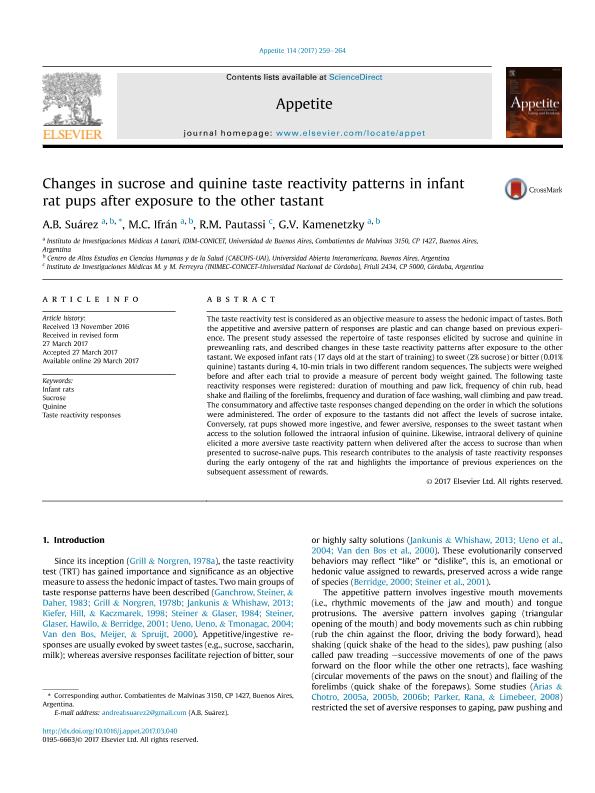Mostrar el registro sencillo del ítem
dc.contributor.author
Suarez, Andrea Beatriz

dc.contributor.author
Ifrán, María Celeste

dc.contributor.author
Pautassi, Ricardo Marcos

dc.contributor.author
Kamenetzky, Giselle Vanesa

dc.date.available
2018-06-04T19:59:47Z
dc.date.issued
2017-07
dc.identifier.citation
Suarez, Andrea Beatriz; Ifrán, María Celeste; Pautassi, Ricardo Marcos; Kamenetzky, Giselle Vanesa; Changes in sucrose and quinine taste reactivity patterns in infant rat pups after exposure to the other tastant; Academic Press Ltd - Elsevier Science Ltd; Appetite; 114; 7-2017; 259-264
dc.identifier.issn
0195-6663
dc.identifier.uri
http://hdl.handle.net/11336/47207
dc.description.abstract
The taste reactivity test is considered as an objective measure to assess the hedonic impact of tastes. Both the appetitive and aversive pattern of responses are plastic and can change based on previous experience. The present study assessed the repertoire of taste responses elicited by sucrose and quinine in preweanling rats, and described changes in these taste reactivity patterns after exposure to the other tastant. We exposed infant rats (17 days old at the start of training) to sweet (2% sucrose) or bitter (0.01% quinine) tastants during 4, 10-min trials in two different random sequences. The subjects were weighed before and after each trial to provide a measure of percent body weight gained. The following taste reactivity responses were registered: duration of mouthing and paw lick, frequency of chin rub, head shake and flailing of the forelimbs, frequency and duration of face washing, wall climbing and paw tread. The consummatory and affective taste responses changed depending on the order in which the solutions were administered. The order of exposure to the tastants did not affect the levels of sucrose intake. Conversely, rat pups showed more ingestive, and fewer aversive, responses to the sweet tastant when access to the solution followed the intraoral infusion of quinine. Likewise, intraoral delivery of quinine elicited a more aversive taste reactivity pattern when delivered after the access to sucrose than when presented to sucrose-naïve pups. This research contributes to the analysis of taste reactivity responses during the early ontogeny of the rat and highlights the importance of previous experiences on the subsequent assessment of rewards.
dc.format
application/pdf
dc.language.iso
eng
dc.publisher
Academic Press Ltd - Elsevier Science Ltd

dc.rights
info:eu-repo/semantics/openAccess
dc.rights.uri
https://creativecommons.org/licenses/by-nc-sa/2.5/ar/
dc.subject
Infant Rats
dc.subject
Quinine
dc.subject
Sucrose
dc.subject
Taste Reactivity Responses
dc.subject.classification
Psicología

dc.subject.classification
Psicología

dc.subject.classification
CIENCIAS SOCIALES

dc.title
Changes in sucrose and quinine taste reactivity patterns in infant rat pups after exposure to the other tastant
dc.type
info:eu-repo/semantics/article
dc.type
info:ar-repo/semantics/artículo
dc.type
info:eu-repo/semantics/publishedVersion
dc.date.updated
2018-06-04T17:01:24Z
dc.journal.volume
114
dc.journal.pagination
259-264
dc.journal.pais
Estados Unidos

dc.journal.ciudad
Nueva York
dc.description.fil
Fil: Suarez, Andrea Beatriz. Consejo Nacional de Investigaciones Científicas y Técnicas. Oficina de Coordinación Administrativa Houssay. Instituto de Investigaciones Médicas. Universidad de Buenos Aires. Facultad de Medicina. Instituto de Investigaciones Médicas; Argentina. Universidad Abierta Interamericana; Argentina
dc.description.fil
Fil: Ifrán, María Celeste. Consejo Nacional de Investigaciones Científicas y Técnicas. Oficina de Coordinación Administrativa Houssay. Instituto de Investigaciones Médicas. Universidad de Buenos Aires. Facultad de Medicina. Instituto de Investigaciones Médicas; Argentina. Universidad Abierta Interamericana; Argentina
dc.description.fil
Fil: Pautassi, Ricardo Marcos. Consejo Nacional de Investigaciones Científicas y Técnicas. Centro Científico Tecnológico Conicet - Córdoba. Instituto de Investigación Médica Mercedes y Martín Ferreyra. Universidad Nacional de Córdoba. Instituto de Investigación Médica Mercedes y Martín Ferreyra; Argentina
dc.description.fil
Fil: Kamenetzky, Giselle Vanesa. Consejo Nacional de Investigaciones Científicas y Técnicas. Oficina de Coordinación Administrativa Houssay. Instituto de Investigaciones Médicas. Universidad de Buenos Aires. Facultad de Medicina. Instituto de Investigaciones Médicas; Argentina. Universidad Abierta Interamericana; Argentina
dc.journal.title
Appetite

dc.relation.alternativeid
info:eu-repo/semantics/altIdentifier/doi/https://dx.doi.org/10.1016/j.appet.2017.03.040
dc.relation.alternativeid
info:eu-repo/semantics/altIdentifier/url/https://www.sciencedirect.com/science/article/pii/S0195666316307553
Archivos asociados
